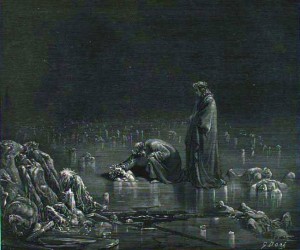
The Battle of Montaperti, the first major and, perhaps, most well known battle between the two city-states occurred on September 4th, 1260. The battle, commonly known as the bloodiest day of the Italian Middle Ages, found its roots in the conflicting ideologies between two groups, the Guelphs and the Ghibellines. The Guelphs, who by 1260 had gained influence over Florence, aligned themselves with the Papacy, whereas the Ghibellines, who had power in Siena, supported the Holy Roman Empire. Despite the fact that the two cities had signed ‘an eternal peace” on July 31st, 1255, the friction between them eventually reached a boiling point due to a handful small skirmishes and overall ill will. In the early fall of 1260, the Florentines and their Tuscan allies assembled an army of 35,000 and marched towards Siena. Siena, led by a Ghibelline who had been exiled from Florence named Farinata degli Uberti, summoned only 20,000 men, but prepared to defend their city all the same. The armies met at a hill called Montaperti, hence the name of the battle. The hill, renamed Montaperti after the battle, directly translates to ‘hill of death’. In the traditional battle stratagem of the era, both armies focused on overtaking the opposing ‘Carroccio’, or, “the holy wagon that always accompanied medieval Italian armies, where priests celebrated mass during the battle.” The battle waged on for the entire day, proving to be a stalemate, despite the superior numbers of the Florentines. This brief video will provide a mental image for the battle that occurred during an age where tactics and weapons were much, much different and a lot simpler.
Eventually, the first point of reference found in Dante’s Inferno turned the tide of the battle. Bocca degli Abati, a (secretly) Ghibelline man fighting for Florence pretending to be a Guelph, made his way across the Florentine line, found the standard bearer (the man holding the flag, a point of organization for the entire army), and chopped off his hand, the flag dropping to the ground. A sense of panic set in among the Florentines, and the Sienese seized the moment and launched an all-out attack. The battle swayed permanently in favor of Siena, and the Florentines were hurt with heavy losses. In the nine ring of Hell in Dante’s Inferno, one will find Bocca degli Abati. This ring, the closest ring to the core of Hell where Satan resides, is reserved for traitors who are eternally stuck in ice up the their chins. Dante’s reference to Abati goes as follows.
Someone yelled, ‘What the devil’s eating you, Bocca? Isn’t it enough to chatter away with your jaws? Do you have to bark too?’ ‘So!’ I exclaimed. ‘Now there’s no need for you to say anything, you wicked traitor! Now I can expose the shameful truth about you to the light of day!

Dante, a Guelph himself, found a personal connection to this conflict and let Bocca degli Abati’s treachery live on in his seminal work, Inferno. The Battle of Montaperti played a major role in the history of the Italian Peninsula, and set the stage for both Siena and Florence to continue their conflict for the next few centuries.